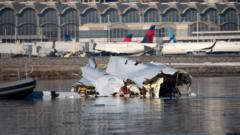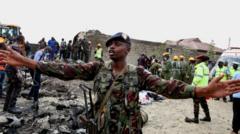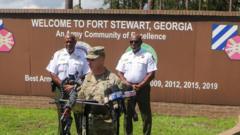Search continues for victims as investigators uncover critical black box data.
**Tragedy in the Skies: Investigation Underway After Fatal DC Plane Crash**

**Tragedy in the Skies: Investigation Underway After Fatal DC Plane Crash**
Fatal aviation incident raises concerns over staffing shortages and air traffic control effectiveness.
The search continues for answers following a disastrous plane crash in Washington, DC, where a commercial airliner collided with a military helicopter, resulting in the loss of 67 lives. The black boxes — the flight data and cockpit voice recorders — have been recovered and will be analyzed by the National Transportation Safety Board (NTSB). The investigation not only seeks to deduce the crash's cause but also highlights staffing issues plaguing air traffic control at Reagan Washington National Airport.
Sources reveal that the airport, known for having one of the most monitored airspaces globally, was operating with just one air traffic controller during the critical landing procedures of a Bombardier CRJ700 flight on Wednesday evening. This logjam in personnel was reported by the Federal Aviation Administration (FAA) as "not normal," intensifying scrutiny of air traffic control protocols.
The collision occurred around 9 PM local time when the American Airlines flight, carrying 64 passengers, struck a U.S. Army Black Hawk helicopter on a training mission. Tragically, no survivors have been identified among those aboard.
As divers resume searching the icy Potomac River for additional victims, the recovery efforts have so far led to the retrieval of 27 bodies from the airliner and one from the helicopter. President Trump, during a White House briefing, offered condolences while casting suspicion on previous staffing standards and policy implementations concerning aviation safety, suggesting they may have contributed to the accident. He moved to eliminate diversity, equity, and inclusion initiatives within the aviation sector, drawing further attention to regulatory frameworks that some deem faulty.
The plane, which took off from Wichita, Kansas, was also carrying two young Russian figure skaters and their mothers, highlighting the personal tragedy intertwined with national concerns of air safety. Kremlin officials expressed sorrow for their citizens' loss, emphasizing the widespread impact of this calamitous event.
As the NTSB gears up to release findings within 30 days, many are left asking: in an environment considered among the most regulated in the world, how could such a catastrophic oversight occur?
Sources reveal that the airport, known for having one of the most monitored airspaces globally, was operating with just one air traffic controller during the critical landing procedures of a Bombardier CRJ700 flight on Wednesday evening. This logjam in personnel was reported by the Federal Aviation Administration (FAA) as "not normal," intensifying scrutiny of air traffic control protocols.
The collision occurred around 9 PM local time when the American Airlines flight, carrying 64 passengers, struck a U.S. Army Black Hawk helicopter on a training mission. Tragically, no survivors have been identified among those aboard.
As divers resume searching the icy Potomac River for additional victims, the recovery efforts have so far led to the retrieval of 27 bodies from the airliner and one from the helicopter. President Trump, during a White House briefing, offered condolences while casting suspicion on previous staffing standards and policy implementations concerning aviation safety, suggesting they may have contributed to the accident. He moved to eliminate diversity, equity, and inclusion initiatives within the aviation sector, drawing further attention to regulatory frameworks that some deem faulty.
The plane, which took off from Wichita, Kansas, was also carrying two young Russian figure skaters and their mothers, highlighting the personal tragedy intertwined with national concerns of air safety. Kremlin officials expressed sorrow for their citizens' loss, emphasizing the widespread impact of this calamitous event.
As the NTSB gears up to release findings within 30 days, many are left asking: in an environment considered among the most regulated in the world, how could such a catastrophic oversight occur?






















